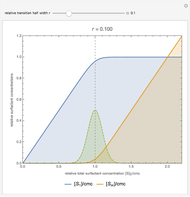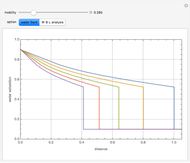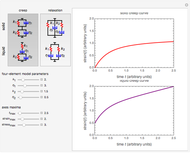Principal Stresses in Compacted Cohesive Powders

Requires a Wolfram Notebook System
Interact on desktop, mobile and cloud with the free Wolfram Player or other Wolfram Language products.
This Demonstration applies the Warren–Spring equation to calculate the unconfined yield stress, major consolidation stress, and effective angle of internal friction of a cohesive powder's compact. The input parameters are the initial consolidation (normal) stress, the yield loci curve's curvature parameter, the compact's cohesion, and its tensile strength. The principal stresses are calculated by finding two tangential Mohr semicircles, one corresponding to the consolidation condition and the other to the strength of the free surface.
Contributed by: Mark D. Normand and Micha Peleg (March 2011)
Open content licensed under CC BY-NC-SA
Snapshots
Details
This Demonstration helps to visualize the effects of the Warren–Spring equation parameters and consolidation conditions on the shape of the yield loci curve and a powder compact's strength. It can also be used to assess the flowability of cohesive powders from experimentally determined shear parameters. It finds and plots the Mohr semicircles that are tangential to the generated yield loci curve of a consolidated powder. The yield loci curve is described by the Warren–Spring equation  , where
, where  is the shear stress,
is the shear stress,  the cohesion,
the cohesion,  a curvature index,
a curvature index,  the normal stress, and
the normal stress, and  the tensile strength. The input parameters are the initial consolidation stress,
the tensile strength. The input parameters are the initial consolidation stress,  and the Warren–Spring equation's coefficients,
and the Warren–Spring equation's coefficients,  ,
,  , and
, and  , presumably obtained from experimental shear data by nonlinear regression. Their values are entered using sliders. This Demonstration solves three pairs of simultaneous equations to find the unconfined yield stress
, presumably obtained from experimental shear data by nonlinear regression. Their values are entered using sliders. This Demonstration solves three pairs of simultaneous equations to find the unconfined yield stress  , the major consolidation stress
, the major consolidation stress  , and the slope
, and the slope  of the line tangent to the Mohr semicircle used to calculate
of the line tangent to the Mohr semicircle used to calculate  , which defines the effective angle of internal friction. Their calculated values are displayed above a plot that depicts the yield loci curve, the two corresponding Mohr semicircles and the line used to find tan
, which defines the effective angle of internal friction. Their calculated values are displayed above a plot that depicts the yield loci curve, the two corresponding Mohr semicircles and the line used to find tan  .
.


 ,
,  ,
,  ,
,  ,
,  ,
,  , and
, and  are in stress units (e.g., kPa),
are in stress units (e.g., kPa),  is dimensionless, and
is dimensionless, and  is in degrees.
is in degrees.
Note that not every possible plot produced by the demonstration corresponds to a real powder compact.
Snapshot 1: cohesive powder: yield loci curve with high degree of curvature and large angle of internal friction
Snapshot 2: cohesive powder: yield loci curve with low degree of curvature and small angle of internal friction
Snapshot 3: cohesive powder: linear yield loci curve and large angle of internal friction
Snapshot 4: "almost free-flowing" powder: almost linear yield loci curve and small angle of internal friction
References:
M. D. Ashton, R. Farely, and F. H. H. Valentin, "Some Investigations into the Strength and Flow Properties of Powders," Rheologica Acta, 4(3), 1965 pp. 206–218.
J. C. Williams, "The Storage and Flow of Powders," in M. J. Rhodes, ed., Principles of Powder Technology, New York: Wiley, 1990.
J. Schwedes, "Review on Testers for Measuring Flow Properties of Bulk Solids," Granular Matter, 5, 2003 pp. 1–43.
Permanent Citation



































